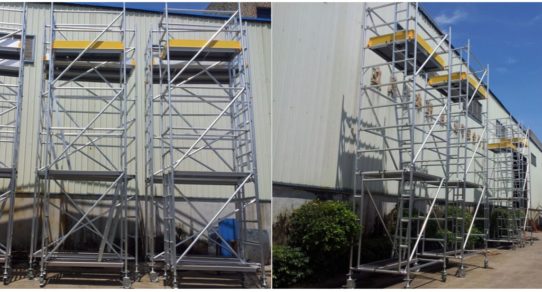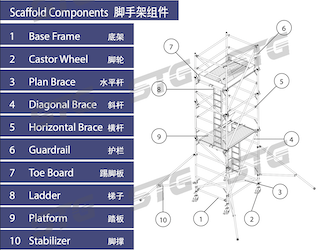Scaffolding is a common sight on construction sites across Singapore. However, because of the inherent risk of accidents, erecting and working on a scaffolding should always be done under a comprehensive set of safety protocols. These safety protocols are applicable to every scaffolding structure incorporated into a building’s construction, including mobile scaffolding towers – which are scaffoldings that come with wheels. In this article, you are going to learn a few safety tips that should be followed when using mobile scaffolding towers.
What Are Mobile Scaffolding Towers?
A mobile scaffolding tower is a structure designed with castor wheels. As they can be easily moved, mobile tower scaffolds are often used to carry out tasks such as painting and plastering. Unlike many other types of scaffoldings, mobile tower scaffoldings can be used both indoors and outdoors. However, when working on a mobile tower scaffold, workers must be extra cautious than when working on other types of scaffoldings. This is because they can move and cause slips and falls amidst operations if the brakes are not properly locked down .
What to Consider When Utilising a Mobile Tower Scaffold?
The use of mobile scaffoldings becomes inevitable when it comes to certain construction and maintenance projects. Even though they have risks attached, by implementing strict safety protocols, construction companies can avoid them and create a secure work environment that safeguards workers.
Following safety standards and regulations not only protects workers from injuries but also ensures legal compliance and prevents unnecessary complications. It builds a reputation of trustworthiness among construction workers and saves a lot of unnecessary expenses in the long run by reducing the rates of accidents, injuries, and property damage. Below are a few tips that you can follow in order to avoid hazards when working with mobile scaffolding towers on construction sites.
1. Inspect the Scaffolding Prior to the Use
Proper inspection is the key to avoiding many accidents. You should never step onto a mobile tower scaffold without proper inspection. When inspecting, make sure to look for loose or damaged components, such as missing or cracked poles, faulty wheels, or rusted joints, and ensure that all locking mechanisms are in good condition. If any defects are detected, immediately report them to the site supervisor and refrain from using the scaffolding until the necessary repairs or replacements are done.
2. Secure the Base
When it comes to mounting a mobile tower, you should also remember to properly secure the wheels. As mobile scaffolding towers stand on wheels, it is crucial to lock and secure them tightly before getting onto them. It is highly advised to place the scaffold on a levelled surface free from debris or obstacles. If the ground is uneven, you can use adjustable legs or swivel base plates to create a stable foundation. Additionally, you should be using stabilisers or outriggers for stability to comply with the regulations.
3. Ensure Even Weight Distribution
When working on one, you should always ensure not to overload the scaffolding beyond its specified weight limit of 200kg per working platform as it can compromise its integrity, increasing the risk of a collapse. To prevent scaffold toppling, you may distribute the load evenly across the platform and avoid concentrating excessive weight on one side. Extra caution must be taken when using a hoist or a pulley system to lift up heavy equipment such as aircon compressors, glass windows and canopy awnings.
4. Personal Protective Equipment (PPE)
It is mandatory for every construction employee to wear personal protective equipment. A PPE kit should essentially include safety helmets, high-visibility vests, safety harnesses, hand gloves, and non-slip safety shoes when working on mobile scaffolding structures. PPE worn by workers should be regularly inspected and replaced if damaged or worn out.
5. Follow Manufacturer’s Instructions
In addition to the above, the assembly of a mobile scaffolding tower should always be done under the manufacturer’s instructions in order to prevent accidents. Each scaffolding will have specific guidelines for assembly, dismantling, and usage. Therefore, adhering to proper instructions is the key to assembling a safe mobile scaffolding tower with structural integrity. In case of doubt, it is highly recommended that you consult the manufacturer of the scaffolding at the earliest.
6. Weekly Inspections
Mobile tower scaffolding is a popular structure used in construction and maintenance projects. Incorporating a mobile tower scaffolding into your construction site undoubtedly provides a lot of convenience, however these scaffoldings also require strict adherence to safety protocols. Inspecting the scaffolding before use, securing wheels, ensuring proper weight distribution, wearing proper PPE kits, and following the manufacturer’s instructions when assembling and dismantling are the key steps to preventing accidents and ensuring the well-being of workers when utilising a mobile tower scaffold. The mobile towers must be inspected by a competent scaffold supervisor once every 7 days. You are obligated to keep a scaffold register of weekly inspection records and put up a safe / unsafe to use tag at the access point to notify users of its status.
Rent Safe and Reliable Scaffolding Structures from Kim Sing Scaffolding
Kim Sing Scaffolding is a leading scaffolding provider in Singapore. With an excellent track record and commitment to safety, at Kim Sing Scaffolding we provide high-quality mobile tower scaffolds, tubular scaffolds, aluminium scaffolds, and much more at reasonable rates. Our experienced team ensures that each scaffolding is in excellent condition and meets all safety standards. Whether you require scaffolding for small-scale maintenance projects or large construction sites, we have got you covered. Click here and visit our website for more information.





